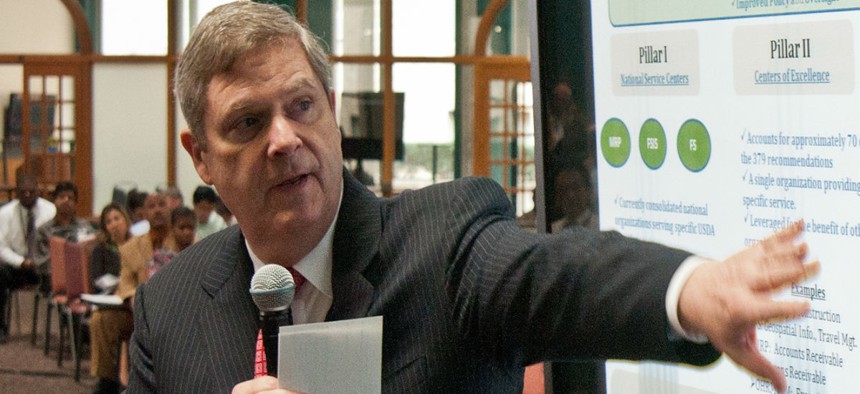
Agriculture Secretary Tom Vilsack speaks about the Blueprint for Stronger Service Initiative in 2012. Bob Nichols/USDA file photo
Agriculture Department Identifies $1.4 Billion in Savings to Avoid Furloughs
Travel cutbacks, telework and office consolidations contribute to three-year-old cost-reduction efforts.
Making good on a pledge to plan for savings that preempt sudden furloughs, Agriculture Secretary Tom Vilsack on Wednesday identified $1.4 billion in “proactive” savings and efficiencies being implemented under the agency’s 2012 “Blueprint for Stronger Service.”
At a time when the farming sector is experiencing its “most productive period in history,” Vilsack said, his team is identifying cost-avoiding reforms and modernizing operations “to become a stronger and more effective department” in the wake of a 10 percent cut in its budget since 2010.
“To produce better results for the farmers, ranchers, small businesses and families we serve, and to stay ahead of the year over year reductions to USDA's operating budget made by Congress, today's USDA must operate much differently than we did in years past," Vilsack said in a statement. "Through our Blueprint for Stronger Service strategy, we took a hard look at our programs and practices and made proactive, cost-saving changes that are innovative and commonsense.”
He said the $1.4 billion in savings will come “without sacrificing service to the American public—a clear victory for our customers, the taxpayer and our department's future. This strategic approach will help USDA continue to support a vibrant and growing agricultural and rural economy for generations to come."
The plan originally envisioned the closing of 259 domestic offices, facilities and labs in the United States and seven foreign offices. Though many were closed, a spokesman told Government Executive, efforts to shutter, for example, some 30 Farm Service Agency offices that lack a full-time staff were blocked by Congress. The department has since included workforce reductions through “targeted use” of Early Retirement and Voluntary Separation authorities to save $142.8 million.
Consolidating some component agencies and “right-sizing” offices in Washington, D.C., and elsewhere created more than $25.2 million in efficiencies, the department said. Planners also ended some planned or ongoing construction projects and disposed of unneeded property to save $268 million.
Cutbacks on employee travel, along with improvements in trip booking procedures, saved more than $400.3 million.
Purchasing goods and services via centralized contracts at the department level rather than through individual agencies saved $169 million. While switching to cloud computing, USDA has found $135 million in efficiencies by updating agreements for information technology support and services, centralizing data servers, consolidating cell phone services and avoiding excess IT equipment purchases.
Improving general management processes brought a claim of more than $57 million in savings. These included “eliminating redundant functions, establishing hiring hubs, and implementing Lean Six Sigma and other management improvement techniques,” the department said.
Embracing online publications while reducing the number of subscriptions and centralizing printing cut costs by more than $24.43 million.
Increased telework has allowed $18 million of cost avoidance in transit subsidies to employees, and new energy savings practices and in cooperation with utility companies in cost control has saved $6.5 million, the department said.
Canceling orders for “unnecessary” promotional items is now saving more than $1.8 million per year.
Future efforts under the blueprint, the department said, will focus on strengthening the strategic sourcing of goods and services and streamlining property management and lease acquisition—all among the Obama administration’s second-term management priorities.
The same day the efficiencies were tallied publicly, the department joined with the Homeland Security Department to announce a ground-breaking for construction of a $1.25 billion National Bio- and Agro-Defense Facility in Manhattan, Kan.
The first-of-its-kind project “will provide the nation with cutting-edge, state-of-the-art lab capabilities and help protect our food supply and the nation’s public health,” said Homeland Security Secretary Jeh Johnson. It “addresses a serious vulnerability. The economic impact of a bio agricultural threat -- deliberate or natural -- could have a substantial effect on the food supply of this nation and have serious human health consequences. We will soon be able to ensure availability of vaccines and other rapid response capabilities to curb an outbreak.”
Vilsack said the lab has “been a national priority for USDA, DHS, and our other partners as we work to replace aging facilities.”







